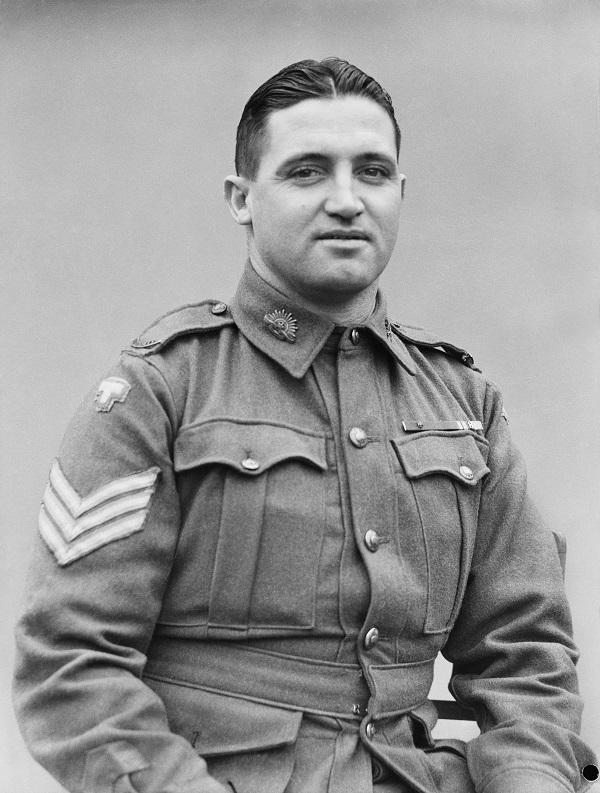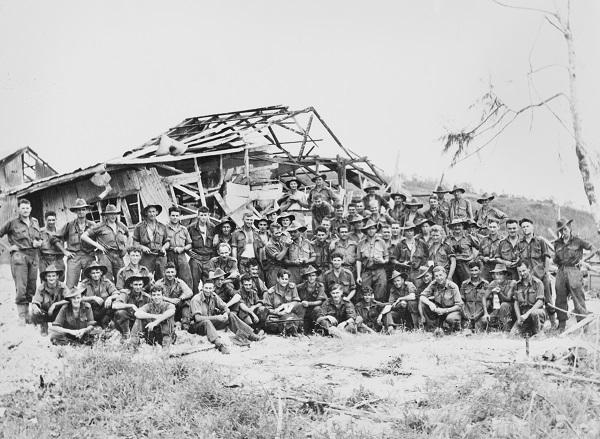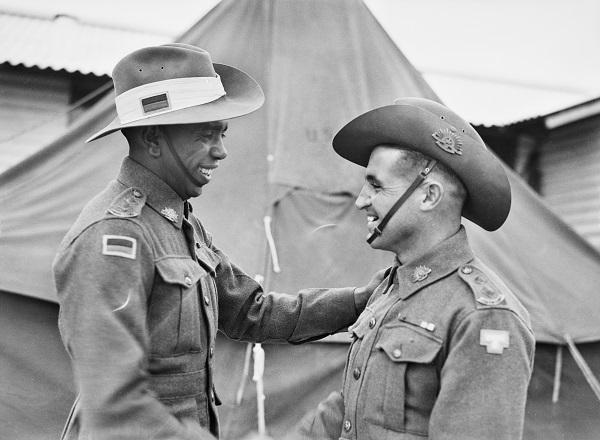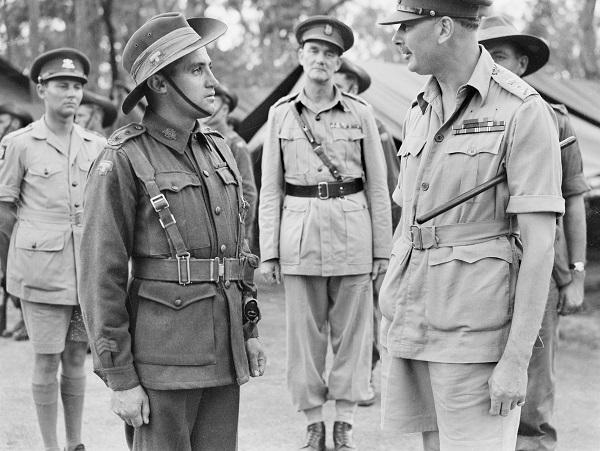In his own words: Diver Derrick
The combat diaries of Diver Derrick reveal the experiences of a much-decorated soldier in the Second World War. By Mark Johnston

Lieutenant Thomas “Diver” Derrick VC DCM
The 75th anniversary of the death on Tarakan of Lieutenant Thomas “Diver” Derrick VC DCM fell on 24 May 2020. Derrick’s wartime diaries constitute one of the most important collections of writings by any Australian soldier. Derrick ranks high among the most famous and decorated Australian soldiers of the Second World War, and his diaries contain a level of detail that astonished many of his comrades who read them after the war. The diaries provide great insight into his outlook and experiences, including the actions for which he was awarded the Distinguished Conduct Medal and the Victoria Cross.
The diaries also contain much information and opinion about the 9th Division’s 2/48th Battalion, the most decorated Australian battalion of the war, including references to hundreds of individuals. Extracts from the diaries have been used in various books, but the original diaries themselves have never been published. They seem to have been destroyed, along with most of Derrick’s enormous wartime correspondence. But the Australian War Memorial holds photocopies, varying in quality, of most of the diaries, and for the last two years I have been working on transcribing and annotating them to make them accessible and comprehensible to a wider audience.
Coming from an impoverished background, Derrick was not an educated man, and his diaries contain many spelling and punctuation errors. However, they also reflect an intelligent, complex and thoughtful mind at work. Here is a sample of diary entries from his four campaigns: Tobruk 1941, Alamein 1942, New Guinea 1943 and Tarakan 1945. Explanatory notes are presented in italics. Each entry begins with the date, the location, and Derrick’s rank and unit at the time. Words not in italics are Derrick’s. Spelling and punctuation mistakes have not been corrected.
Tobruk
1 May 1941 (Thursday)
The Blue Line, Bianca and the Ras el Medauuar area: Tobruk, Libya. Private Derrick, 8 Platoon, A Company, 2/48th Battalion.
Have been shelled all night, but still slept well – our arty [artillery] laying it on strong & heavy now.
The DB’s [dive bombers] again about 30 seem to have scored one hit – 30 Hun tanks have broken through. Let ‘em come.
1800 hrs & we are going to attack, our pln [platoon] on extreme left flank. Went to far left & walked in with Hun tks [tanks]. A real death trap & plenty of casualities, withdrew one mile at 2400.
We are going to attack. The 2/48th launched a counter-attack to regain ground lost in a major Axis attack on 2/24th Battalion positions the previous night. Derrick’s ‘A’ Company was on the left, where it found itself walking alongside tanks, which were not identified as German until 25 yards away. Eventually the Panzers halted and opened fire on the Australians. Unable to continue, Lieutenant Hurtle Morphett ordered the survivors of his platoon, including Derrick, to withdraw, which they did without loss. Murray Farquhar’s biography of Derrick says that Morphett recommended Derrick unsuccessfully for a Military Medal for his actions in this battle. No record of the recommendation survives in the battalion war diary, but this does not mean that Morphett made no such recommendation.
2 May 1941 (Friday)
Behind the Blue Line, Tobruk, Libya.
Out early after a terrible experience – digging in about 1½ miles from front line. 2/10th going forward now – the 2/23 & 2/24 [were] cut about more than us. Will never forget the bloody blue of May the First. My cobber “Hia” Bill Gates shot in head with M.G. [machine-gun] fire, died in a few mins saying goodbye to his inseparable pal “Watha” who is in a pretty bad way about it.
2/10th This fellow South Australian battalion moved into the area of the recent fighting, soon to be called The Salient
2/23 & 2/24 The 2/24th Battalion bore the brunt of Rommel’s attack on 30 April and lost about half its strength, killed or captured in the fighting of 30 April to 1 May. Like the 2/48th, the 2/23rd Battalion counter-attacked that night and was attacked, but it did not suffer heavy casualties.
May the First: On 1 May the 2/48th suffered 51 casualties, including 16 killed.
Derrick reportedly coined the nicknames “Hia” and “Watha” for Pte William Thomas Gates, b. 1910, KIA 1 May 1941; and Gates’ great friend, Pte Rex Alwin Altschwager, who served until war’s end.
El Alamein
10 July 1942 (Friday)
Near Tel el Eisa, Egypt. Corporal Derrick, 8 Platoon, A Company, 2/48th Battalion.
“A” Company had been heavily involved in capturing a vital ridge, and was now advancing through the dark towards Tel el Eisa railway station to make a counter-attack on the Germans, including tanks, who had forced out D Company. Troops that were intended to help “A” Company had not arrived, but it was decided to continue the attack with that company alone. Derrick reflects on this decision.
When the scheme was made known to us I hardly think one man thought he had a chance of getting out of it, I felt sure she was curtains this time, but like the rest of the boys I didnt say so, no one spoke, just listened to orders and prepared themselves.
The plan of attack. We were to move forward in one long extended line cross the Rly [railway] line without a sound and on a shot from the OC we were to open up with everything and continue to advance firing as we went and calling out “Come on Australianoes”.
All went as planned, and from the eerie quietness broke forth the din of LMGs [light machine-guns, the Bren], Tommy guns, rifles and grenades, also the blood curdling cries of advancing men. The enemy must have thought there were thousands, and I think the Australiano business helped a lot. A few of the enemy managed to get to their weapons but the majority were taken by surprise and went bush quick and fast. To mention one small incident: our pl[atoon] which was on the left was making pretty fast progress, Cpl Badman was seen to rush ahead ST bomb in hand after a tank which could be heard retreating but not seen, unfortunately he didnt reach it. From about 30 yds in front of us and under a truck a Machine gun opened up on us, immediately every weapon in the Pl turned in that direction and the MG ceased to fire. Our exploitation was about 700 yds, then Mr Gill turned us back and once more commenced the old favourite, digging in.
ST bomb A No. 74 anti-tank hand grenade, often called a “sticky bomb”. Shell halves covering the sticky part were removed just before it was thrown. Derrick himself used one of these effectively on 15 July 1942.
Mr Gill Lieutenant George Tasman Gill, KIA 23 July 1942. Even in his personal diary, Derrick respectfully calls his platoon commander Gill “Mr”, a title used officially to address and refer to lieutenants.

Sergeant Thomas 'Diver' Derrick DCM hoists the Australian flag above the village of Sattelberg. He was awarded the Victoria Cross for his role in the captue of the village. 3 December 1943. Photo: Neil Brown AWM 016246.
New Guinea
Derrick’s diary entries for the two days before 24 November 1943, the day of his Victoria Cross action.
21 November 1943 (Sunday)
Sattelberg Road beyond 2400 Feature, New Guinea. Sergeant Derrick, commanding 11 Platoon, B Company, 2/48th Battalion
I am sent for by the Col and placed in command of 11 Pl B Coy, they having lost all but one of their leaders. Was immediately given a patrol which occupied 6 hours. Although no enemy were encountered, information obtained was valuable. The pl[atoon] worked marvellously, they impress as a very capable crew, especially acting sec com [section commander] Wally Everett & fwd scout Bob McKenzie. 1630 hrs D Coy pushed on behind A who had advanced 450 yards along the road without opposition. 1730 hrs again moved up a further 200 yards and again dug in late.
The Col Lieutenant-Colonel Ainslie, the Commanding Officer of the 2/48th. Received DSO at Sattelberg in November 1943.
Placed in command of 11 Pl: A position normally held by an officer.
Wally Everett ended the war a lance-sergeant. Derrick’s appreciation was returned by Everett, who said later, “Gee! We were glad to have someone like him take over the platoon.”
Bob McKenzie ended the war as a corporal.
22 November 1943 (Monday)
My pl[atoon] to go patrolling, a very sticky one up to the ford just below Satelberg. Left at 0830 had gone 150 yards and heard 5 Japs 50 yards ahead saw another 10 digging in above the ford. Reported this and the arty F.O.O. [forward observation officer] Capt Henderson came up; result – a lacing from our 25-pounders. Patrol pushed on. Found very recent signs of Jap occupation. Remainder of Coy moved up, patrol pushed along ridge running parallel to road until directly above the ford and first elbow in road. Could not get down to ford, our bombing having made huge landslides and blasted out all trees & other growth, to move further would have placed us under Jap observation from a ridge 200 yards away. The road & its condition could easily be seen, also enemy movement & posns [positions] on Satelberg. Whilst making this recce firing opened less than 50 yards on our left & upward flank, it was C Coy of the 2/23 Bn in contact with the Tojo, a planned recognition signal, again the famous Ho Ho gave us contact with 23rdwho after pushing Japs off occupied the ground we were holding. We returned to our former posn.
25 pounders Australian artillery pieces
Under Jap observation: Derrick was not willing to take unnecessary risks here.
Posns on Satelberg: These observations may have been useful to Derrick on 24–25 November, when he was among those very positions.
The famous Ho Ho: On the Atherton Tablelands earlier in 1943, 9th Division units had begun “dog-barking”, often rendered as a “ho ho” sound. It became a 9th Division battle cry. General Wootten, who took over the 9th Division in March 1943, had in Australia called for the custom to cease. The 2/48th War Diary says that this was the second occasion on which it prevented the battalions from inflicting mutual casualties, and asserted, “It has come to stay.”
Two days later, Tom Derrick led 11 Platoon in the capture of the precipitous and strongly defended Sattelberg heights, the key to the whole mountainous area in which thousands of troops had been fighting for a month. The citation for the Victoria Cross he was subsequently awarded stated that his “outstanding gallantry, fine leadership and refusal to admit defeat in the face of a seemingly impossible situation resulted in the capture of Satelberg.”

Australian infantrymen who took part in capturing the village of Sattelberg in November 1943 outside a bomb-damaged hous. Photo: Neil Brown AWM 016239
Tarakan
The initial landing was made on 1 May to capture the island of Tarakan, off Borneo.
2 May 1945 (Wednesday)
Collins Highway Ridge, Tarakan. Lieutenant Derrick, commanding 7 Platoon, A Company, 2/48th Battalion.
Had a reasonably quiet night was not attacked. Remaining in this position until further orders. Pl[atoon] met trouble during night. Japs stalked 8 Sec, sliced the top of L/Cpl Murphy’s head off, the Jap was found at daybreak 50 yds away, was wounded in the [illegible]. He was smartly killed.
Lt. J Collier killed on patrol ran into ambush. Another patrol of Lt Buckley’s was ambushed & received 4 wounded.
L/Cpl Murphy: The attackers were using fused 75mm shells and knives attached to bamboo poles.
Lt Buckley: Now commanding 11 Platoon, which Derrick had led at Sattelberg in his Victoria Cross action.

Newly promoted lieutenants Reg Saunders and Tom Derrick shake hands after graduating from the Officer Cadets Training Unit at Seymour, Victoria, 25 November 1944. Photo: Keith Rainsford AWM 083166
6 May 1945 (Sunday)
Otway feature, Tarakan.
C Coy moving thru to take Sykes. I took a 2 sec[tion] patrol to Snags Track encountered no enemy, had to return to dodge an air strike that was to be launched at 1200, arrived back at 1150 hrs.
C Coy having a stiff fight, Tojo has blown the road & tanks are temporarily held up.
1400 hrs. C Coy have made 3 attempts to take Sykes – 8 Pl A Coy are in with them – thru out the afternoon fire was heavy, our casualties were many, by 1700 hrs the show had quietened down somewhat. 8 Pl have had 4 cas[ualties]. Sjt Mackay has been taken from me to command 8 Pl, their sjt having been wounded. We are to relieve C Coy tonight sometime.
2 sec patrol: Probably a patrol two sections strong and described in the 2/48th War Diary as “a small patrol along a spur running NE from Otway”.
Stiff fight: 13 and 14 Platoons were involved in heavy fighting on Sykes. Sergeant Glyn Pope of 14 Platoon was awarded a DCM after leading his men up Sykes under a shower of grenades. Six Australians were killed, 26 wounded in this action.
William Keith Mackay ended the war a sergeant with the 2/48th. Derrick was instrumental in obtaining his promotion in order to make him Platoon Sergeant for 7 Platoon.
Casualties: The battalion suffered 6 killed and 26 wounded on this day; 30 enemy dead were counted and one other believed killed.
Eighteen days after writing this entry, Lieutenant Tom Derrick VC DCM died of wounds on Tarakan, aged 31.

Prince Henry, Duke of Gloucestershire and Governor General of Australia, with Lieutenants Tom Derrick VC DCM during a visit to Ravenshoe, 14 February 1945 Photo: AWM 086691.
About the author
Mark Johnston is the author of 11 books on Australians in the Second World War. His version of Derrick’s diaries and other wartime writings and interviews will be completed this year. Readers with any of Derrick’s unpublished writings are invited to contact him at mark.johnston@scotch.vic.edu.au.